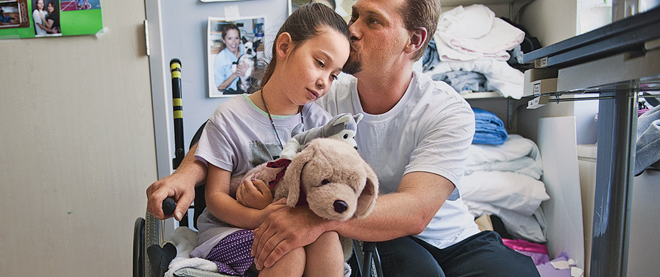A radical new rabies treatment
For the first time people are surviving the infection without vaccinations—but is this therapy too risky?
Photo: © Sacramento Bee/ZUMAPRESS.com
Share

On Sept. 12, 2004, 15-year-old Jeanna Giese bent down to pick up a wounded bat in her hometown of Fond du Lac, Wis. When the creature bit her left index finger, she treated the cut like any other (with hydrogen peroxide) and carried on with her life. But a month later, Giese was struck with double vision, slurred speech, and a fever of 102° F. Doctors tested her for several infections but each result came back negative. Finally, her mother recalled the bat bite and doctors filled in the blank: Jeanna had rabies—a viral infection that causes acute encephalitis and is almost always fatal when victims do not receive a vaccine of immunoglobulin immediately after infection.
But Rodney Willoughby Jr., a 55-year-old physician at the Children’s Hospital of Wisconsin, would challenge that notion with a radical therapy called the “Milwaukee protocol,” and Giese would become the first-known person to survive a rabies infection without receiving an inoculation. “We decided to use a strategy,” explains Willoughby, “where we would support the patient for a natural immune response to clear the infection.” Willoughby wanted to see if Giese’s immune system could, under the right conditions, overcome rabies on its own. He sedated Jeanna, inducing a coma (Willoughby has since moved to a lighter sedation), and put her on a number of antiviral drugs, believing that a dormant brain would keep her alive longer and allow the body to marshal its defences more effectively. “One in five rabies patients die of heart stoppage in the first week of treatment,” says Willoughby, “and if you sedate the brain then the brain can’t [stop the heart].” Jeanna suffered some brain damage from the sedation, but the treatment worked: her brain slept while her body fought off the disease, says Willoughby. “All we do,” he adds, referring to the most recent guidelines of his protocol, “is essentially provide you with a breathing tube and give you a couple medicines to keep you out of trouble. Then we let your immune system do what it has to do.” Willougby called his treatment the Milwaukee protocol after the city where the first treatment took place, and has made it accessible online for doctors around the world. Giese, now 21, graduated from Lakeland College in May, with a degree in biology.
In the last seven years, five other patients, from Qatar to Peru, have survived rabies after undergoing the Milwaukee protocol. The most recent success story is Precious Reynolds, an 11-year-old from northern California, who beat the infection in July. Precious attends a rural public school in Willow Creek, Calif., where the teachers and students regularly fed and played with feral cats. “It turns out Precious was the queen of the hill,” says Willoughby, who was in contact with the girl’s doctor throughout her treatment. “She handled the cats the most. That was probably the cause of exposure.”
Precious is currently recovering rapidly from the virus, says Willoughby, showing no signs of brain damage from the sedation. But not every protocol-aided survivor has been so lucky. Some suffer from “locked-in syndrome,” a condition of almost complete physical paralysis (some patients can move only an eyelid) resulting from the sedation. It’s this kind of outcome that has kept Willoughby’s innovation on the medical periphery. In fact, in many parts of the world, his methods are vehemently discouraged. “In Asia and elsewhere,” says Thiravat Hemachudha, a Thai neurologist and rabies expert, “we strongly recommend not to apply this to any of our patients.” Hemachudha argues that heavy sedation is unnecessary and dangerous—a criticism Willoughby says he is all too familiar with. “We are regularly pummelled at scientific meetings,” he says. “Critics say that our survivors are natural survivors, and would have lived even if we hadn’t done the protocol.” Another common criticism is that the method prolongs suffering and offers false hope. To date, the protocol has been used on approximately 38 patients, six of whom have survived.
Worldwide, 50,000 people die of rabies each year, a figure that makes the protocol’s success rate unimpressive to its critics. But it’s a start, argues Willoughby, especially considering the dearth of spontaneous recoveries without it. He is also quick to note that the professors he trained under in medical school were some of the first doctors to try to treat childhood leukemia—an undertaking regarded at the time with similar disdain. Like rabies, explains Willoughby, childhood cancers were once believed to be 100 per cent fatal, and not worth treating. “But they didn’t buy that,” he says of his professors. “Now, 40 years later, it’s 80 per cent survival at five years.” It seems—unlike many of his contemporaries—that Willoughby is more invested in the science of possibility than sheer probability. Or as he likes to put it, “Better six survivors than none at all.”